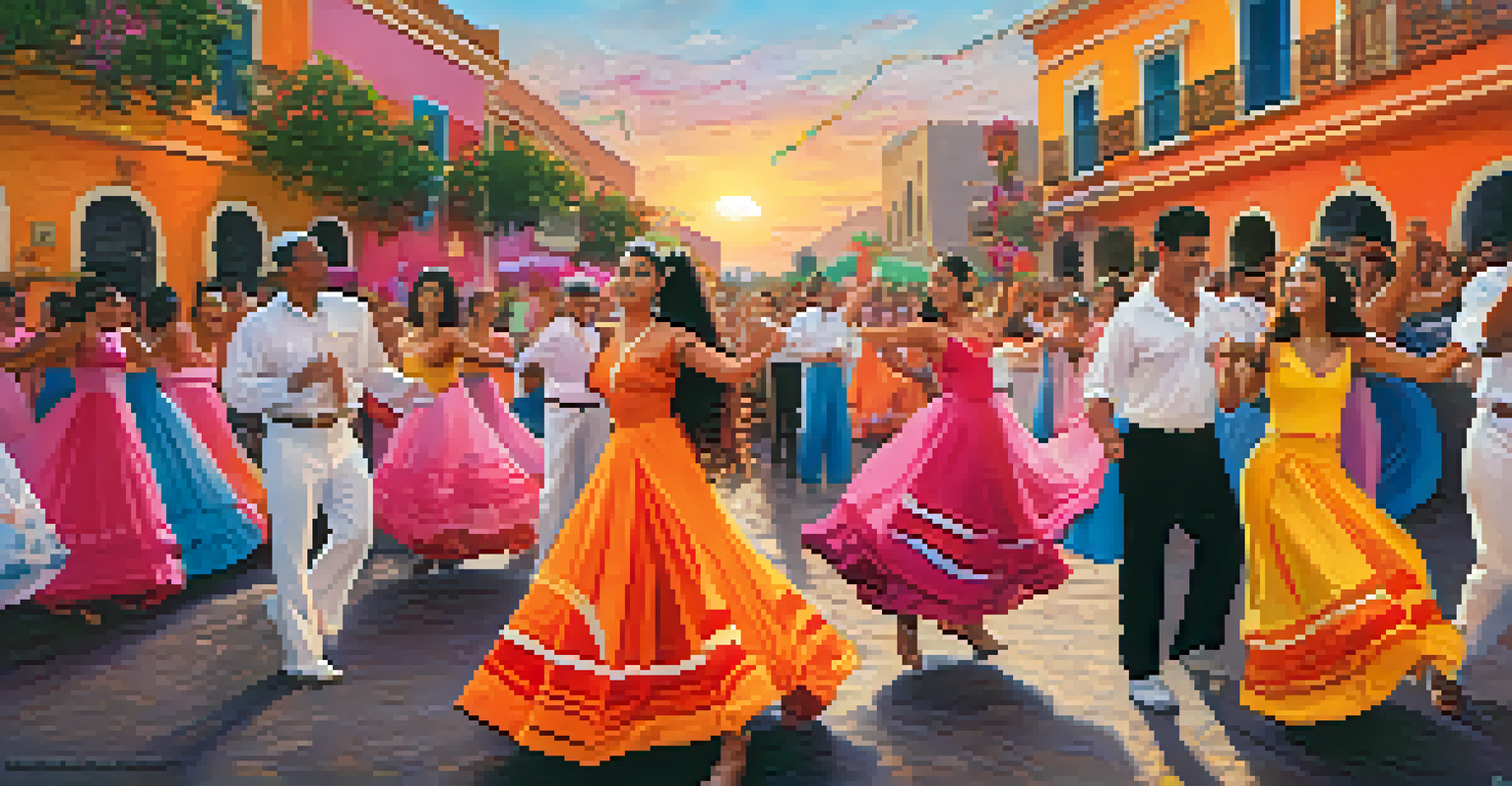Latin Music and Identity: Celebrating Heritage Through Rhythm

The Pulse of Latin Music: A Cultural Heartbeat
Latin music is more than just a genre; it's a vibrant expression of culture and identity. It serves as a heartbeat for communities, echoing their histories, struggles, and triumphs. Genres like salsa, reggaeton, and bachata are not just sounds; they carry the stories of generations.
Music is the shorthand of emotion.
When you listen to Latin music, you’re often hearing the influences of indigenous cultures, European colonization, and African rhythms intertwine. This fusion creates a rich tapestry that reflects the diverse backgrounds of Latinx communities. Each note played and lyric sung can transport listeners to a place filled with memories and emotions.
Through dance and celebration, Latin music fosters a sense of belonging and unity. It invites people to come together, breaking barriers and building connections that transcend language and geography.
Rhythm as a Reflection of Identity
Rhythm in Latin music serves as a vital reflection of personal and collective identity. The beats resonate with the experiences of individuals, often mirroring their life stories and cultural backgrounds. For many, dancing to these rhythms is not just enjoyment but an affirmation of who they are.

Take salsa, for example; its lively tempo encourages spontaneous expression and connection. Participants often find themselves lost in the music, where their movements tell a story that words cannot. This natural expression creates a shared experience that strengthens cultural ties.
Latin Music as Cultural Expression
Latin music is a vibrant reflection of cultural identity, weaving together the histories and emotions of communities through its diverse genres.
In essence, every dance and every song is a celebration of identity, allowing individuals to embrace their roots while also sharing them with others. This rhythmic connection fosters a sense of pride and belonging within the community.
The Role of Lyrics in Storytelling
Lyrics in Latin music are powerful narratives that tell stories of love, loss, and resilience. They often reflect the everyday lives and struggles of the people, making them relatable and poignant. This storytelling aspect is crucial in preserving cultural heritage.
The purpose of music is to unite people in a way that no other art can.
For instance, many traditional songs recount historical events or family tales, passing down knowledge through generations. These lyrics are often infused with local dialects and expressions, anchoring them in specific cultural contexts. This use of language not only enriches the music but also serves as a linguistic link to the past.
Moreover, contemporary artists continue this tradition, addressing modern issues while honoring their roots. By weaving personal and political stories into their music, they keep the conversation alive and relevant for today's listeners.
Dance: A Language of Its Own
Dance is an integral part of Latin music, acting as a universal language that transcends cultural and linguistic barriers. Styles like salsa, merengue, and tango invite people to engage physically with the rhythm, creating a visceral connection. Through dance, individuals express feelings that words may fail to capture.
In social settings, dance fosters joyous community interactions, where everyone can participate regardless of skill level. The spontaneity of Latin dance encourages improvisation, allowing dancers to communicate and connect in real-time. This creates an exhilarating atmosphere filled with energy and laughter.
Dance Unites Through Rhythm
Dance serves as a universal language in Latin music, allowing individuals to express their emotions and connect with each other beyond words.
As dancers move to the music, they embody the spirit of their ancestors, honoring a rich tradition that has evolved while remaining true to its roots. Each dance becomes a celebration of identity, culture, and shared joy.
Latin Music's Global Influence
Latin music has transcended borders, impacting global music scenes and inspiring artists worldwide. Its infectious rhythms and melodies have found their way into mainstream pop, hip-hop, and even electronic music. This crossover illustrates the genre's versatility and its ability to resonate with diverse audiences.
Collaborations between Latin artists and musicians from other genres have further propelled this influence. Songs blending reggaeton with pop or trap have topped charts, showcasing the universal appeal of Latin sounds. This fusion not only broadens the listener base but also enriches the global music landscape.
As Latin music continues to evolve, it remains rooted in its cultural identity while embracing innovation. This dynamic exchange ensures that the essence of Latin music thrives, reaching new heights and creating new connections.
Preserving Cultural Heritage Through Music
Latin music plays a crucial role in preserving cultural heritage, serving as a living archive of traditions and values. Many artists dedicate their work to keeping these traditions alive, ensuring that future generations can connect with their ancestry. This commitment to preservation highlights the importance of cultural identity.
Festivals and community events often celebrate these musical traditions, bringing people together to share in the joy of their heritage. Such gatherings foster intergenerational dialogue, where elders pass down stories and teachings through music and dance. This exchange reinforces the significance of cultural continuity.
Global Impact of Latin Sounds
Latin music's infectious rhythms have transcended borders, influencing global music and inspiring collaborations across various genres.
In an increasingly globalized world, these efforts to preserve Latin music are vital. They not only celebrate diversity but also remind us of the shared human experience that music embodies, bridging gaps between cultures.
Looking Ahead: The Future of Latin Music
The future of Latin music looks bright, with an ever-growing audience and a new wave of artists pushing creative boundaries. Young musicians are blending genres, experimenting with sounds that reflect their unique experiences and perspectives. This innovative spirit ensures that Latin music remains fresh and relevant.
As technology advances, so too does the way music is created and shared. Platforms like social media allow emerging artists to showcase their talents to a global audience, breaking traditional barriers. This democratization of music offers exciting opportunities for collaboration and creativity.

Ultimately, the evolution of Latin music will continue to celebrate cultural identity while embracing change. As new rhythms and styles emerge, they will enrich the genre, ensuring that it remains a vital part of the global cultural landscape.